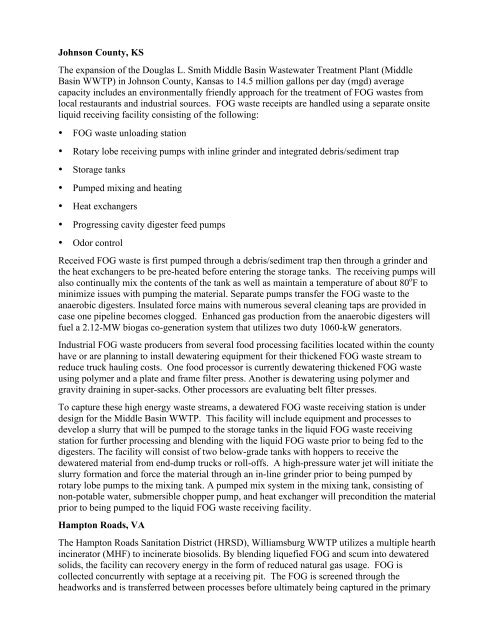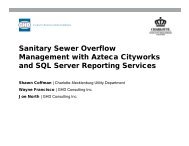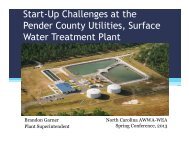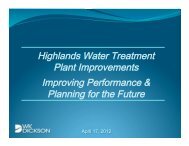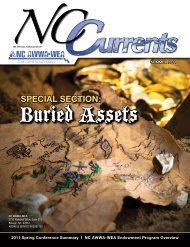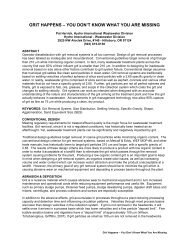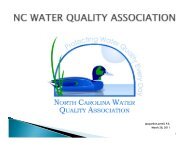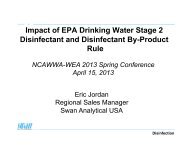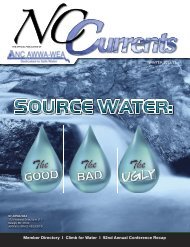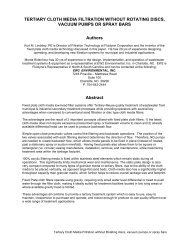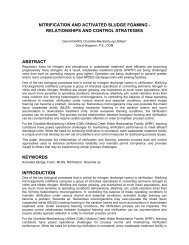HANDLING FATS, OILS & GREASES (FOG) AT WASTEWATER ...
HANDLING FATS, OILS & GREASES (FOG) AT WASTEWATER ...
HANDLING FATS, OILS & GREASES (FOG) AT WASTEWATER ...
Create successful ePaper yourself
Turn your PDF publications into a flip-book with our unique Google optimized e-Paper software.
Johnson County, KSThe expansion of the Douglas L. Smith Middle Basin Wastewater Treatment Plant (MiddleBasin WWTP) in Johnson County, Kansas to 14.5 million gallons per day (mgd) averagecapacity includes an environmentally friendly approach for the treatment of <strong>FOG</strong> wastes fromlocal restaurants and industrial sources. <strong>FOG</strong> waste receipts are handled using a separate onsiteliquid receiving facility consisting of the following:• <strong>FOG</strong> waste unloading station• Rotary lobe receiving pumps with inline grinder and integrated debris/sediment trap• Storage tanks• Pumped mixing and heating• Heat exchangers• Progressing cavity digester feed pumps• Odor controlReceived <strong>FOG</strong> waste is first pumped through a debris/sediment trap then through a grinder andthe heat exchangers to be pre-heated before entering the storage tanks. The receiving pumps willalso continually mix the contents of the tank as well as maintain a temperature of about 80 o F tominimize issues with pumping the material. Separate pumps transfer the <strong>FOG</strong> waste to theanaerobic digesters. Insulated force mains with numerous several cleaning taps are provided incase one pipeline becomes clogged. Enhanced gas production from the anaerobic digesters willfuel a 2.12-MW biogas co-generation system that utilizes two duty 1060-kW generators.Industrial <strong>FOG</strong> waste producers from several food processing facilities located within the countyhave or are planning to install dewatering equipment for their thickened <strong>FOG</strong> waste stream toreduce truck hauling costs. One food processor is currently dewatering thickened <strong>FOG</strong> wasteusing polymer and a plate and frame filter press. Another is dewatering using polymer andgravity draining in super-sacks. Other processors are evaluating belt filter presses.To capture these high energy waste streams, a dewatered <strong>FOG</strong> waste receiving station is underdesign for the Middle Basin WWTP. This facility will include equipment and processes todevelop a slurry that will be pumped to the storage tanks in the liquid <strong>FOG</strong> waste receivingstation for further processing and blending with the liquid <strong>FOG</strong> waste prior to being fed to thedigesters. The facility will consist of two below-grade tanks with hoppers to receive thedewatered material from end-dump trucks or roll-offs. A high-pressure water jet will initiate theslurry formation and force the material through an in-line grinder prior to being pumped byrotary lobe pumps to the mixing tank. A pumped mix system in the mixing tank, consisting ofnon-potable water, submersible chopper pump, and heat exchanger will precondition the materialprior to being pumped to the liquid <strong>FOG</strong> waste receiving facility.Hampton Roads, V<strong>AT</strong>he Hampton Roads Sanitation District (HRSD), Williamsburg WWTP utilizes a multiple hearthincinerator (MHF) to incinerate biosolids. By blending liquefied <strong>FOG</strong> and scum into dewateredsolids, the facility can recovery energy in the form of reduced natural gas usage. <strong>FOG</strong> iscollected concurrently with septage at a receiving pit. The <strong>FOG</strong> is screened through theheadworks and is transferred between processes before ultimately being captured in the primary


